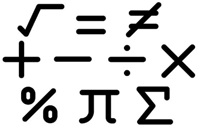

by Maurice Y. Michaud (he/him)
 Mathematics can sometimes be tricky and lead to confusing or counterintuitive results. For instance, think of the “division by zero” error. In some people’s mind, dividing by zero should mean that a number is not to be divided and thus should remain unchanged. In other people’s mind (and according to one of the most fundamental rules of mathematics), it’s impossible to divide something by nothing. But dividing a number by 1 will leave that number unchanged, achieving what the former group thinks a division by zero should do.
Mathematics can sometimes be tricky and lead to confusing or counterintuitive results. For instance, think of the “division by zero” error. In some people’s mind, dividing by zero should mean that a number is not to be divided and thus should remain unchanged. In other people’s mind (and according to one of the most fundamental rules of mathematics), it’s impossible to divide something by nothing. But dividing a number by 1 will leave that number unchanged, achieving what the former group thinks a division by zero should do.
I bring this up simply because no apportioning (or representation) formula can be perfect, and it’s particularly difficult to apply at the federal level. Depending on the dataset (that is, the actual numbers with which we are working), paradoxes can arise. A slight change of a single number within the dataset can lead to significantly different results. While those results are undeniably correct in pure mathematics, they can’t (and don’t) take into account external or “real life” factors.
That being said, a representation formula is far less complicated at the provincial or territorial level than it is at the federal level. Many provinces only need an electoral quotient to get the job done. However, for some provinces, the external or “real life” factors that mathematics cannot account for can include remote or large but sparsely populated areas, or areas that have a significant minority group that should be taken into account. For instance, one can think of the Magdelen Islands of Québec (geographically isolated and in a different time zone as the rest of the province) or the Acadians or Blacks of Nova Scotia (significant cultural groups). But provinces with such situations have the latitude of introducing simple tweaks to their representation formula, such as allowing a greater variance of population to create a few smaller ridings population-wise.
But the representation formula gets more complicated at the federal level, and Elections Canada has to go far beyond simply applying an electoral quotient. For example, a quantity of milk could theoretically be divided down to single molecules. However, Parliament is restricted to having whole numbers, as a province can’t have a quarter- or half-seat. Thus there is always the possibility of a rounding error. But more subtlely, an apportioning formula can lead to a province losing seats despite having a population that is growing, but at a much slower rate than the rest of the country or some other provinces.
The population of British Columbia, Alberta, and Ontario has more than doubled between 1966 and 2022 — tripled, in fact, in Alberta’s case. The population of all the other provinces except Newfoundland and Labrador has also grown during that time, but not by nearly as much. Therefore, a strict mathematical model could lead a province like Prince Edward Island, whose entire population is about the size of a smaller mid-sized city in the rest of Canada, to being allocated only one seat instead of its current four. That obviously wouldn’t go over very well in a province that reluctantly entered Confederation in 1873 with six seats.
For its part, the population of Québec, the country’s second most populous province, has grown by about 50 percent from the early 1970s to the early 2020s. However, its number of seats has remained stable in the range of 73 to 78 since the 1950s because of its demographic weight within the federation, which has been decreasing steadily after each decennial census. Pure mathematics can’t and don’t take into account the province’s distinctive nature as the only majority French-speaking jurisdiction in North America and the need to protect that distinctiveness.
So let’s take a look first at one province, whose representation formula has to be adjusted due to special considerations, before looking at how the federal formula has evolved to what it has become today.
 ” and “Electoral Boundaries
” and “Electoral Boundaries  ” in Chapter 4 (The House of Commons and Its Members), available on the Our Commons website of the Parliament of Canada.
” in Chapter 4 (The House of Commons and Its Members), available on the Our Commons website of the Parliament of Canada. ” Library of Parliament (Canada)
” Library of Parliament (Canada) “ and “House of Commons Seat Allocation by Province 2022—2032
“ and “House of Commons Seat Allocation by Province 2022—2032  .”
.”